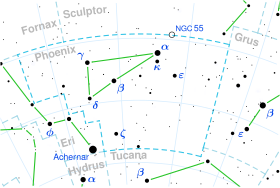Lambda1 Phoenicis
| Observation data Epoch J2000 Equinox J2000 | |
|---|---|
| Constellation | Phoenix |
| Right ascension | 00h 31m 24.98200s[1] |
| Declination | −48° 48′ 12.6759″[1] |
| Apparent magnitude (V) | 4.76[2] |
| Characteristics | |
| Spectral type | A0Va[3] |
| U−B color index | +0.04[4] |
| B−V color index | +0.02[4] |
| Astrometry | |
| Radial velocity (Rv) | −2.0±4.2[5] km/s |
| Proper motion (μ) | RA: +139.946[1] mas/yr Dec.: +21.275[1] mas/yr |
| Parallax (π) | 17.8163 ± 0.2228 mas[1] |
| Distance | 183 ± 2 ly (56.1 ± 0.7 pc) |
| Absolute magnitude (MV) | 1.14[2] |
| Details | |
| Mass | 2.26[6] M☉ |
| Radius | 2.24[7] R☉ |
| Luminosity | 33.68[2] L☉ |
| Surface gravity (log g) | 4.17[6] cgs |
| Temperature | 9,931[6] K |
| Metallicity [Fe/H] | 0.00[8] dex |
| Rotational velocity (v sin i) | 111[6] km/s |
| Age | 224[6] Myr |
| Other designations | |
| Database references | |
| SIMBAD | data |
λ1 Phoenicis, Latinized as Lambda1 Phoenicis, is a double star[10] in the southern constellation of Phoenix. It is visible to the naked eye as a faint, white-hued point of light with a combined apparent visual magnitude of 4.76.[2] The system is located approximately 183 light years away from the Sun based on parallax.[1] It is a member of the Hyades Supercluster.[11]
The brighter component is an A-type main-sequence star with a stellar classification of A0Va.[3] It may form a binary system of two roughly equal stars.[10] An infrared excess suggests there is a debris disk orbiting 46.3 AU from the star with a mean temperature of 95 K.[7] It has one visual companion at an angular separation of about 30″ and magnitude 13.7.[12][13]
References[edit]
- ^ a b c d e f Brown, A. G. A.; et al. (Gaia collaboration) (August 2018). "Gaia Data Release 2: Summary of the contents and survey properties". Astronomy & Astrophysics. 616. A1. arXiv:1804.09365. Bibcode:2018A&A...616A...1G. doi:10.1051/0004-6361/201833051. Gaia DR2 record for this source at VizieR.
- ^ a b c d Anderson, E.; Francis, Ch. (2012). "XHIP: An extended hipparcos compilation". Astronomy Letters. 38 (5): 331. arXiv:1108.4971. Bibcode:2012AstL...38..331A. doi:10.1134/S1063773712050015. S2CID 119257644. Vizier catalog entry
- ^ a b Gray, R. O.; Garrison, R. F. (1987). "The Early A-Type Stars: Refined MK Classification, Confrontation with Stroemgren Photometry, and the Effects of Rotation". The Astrophysical Journal Supplement Series. 65: 581. Bibcode:1987ApJS...65..581G. doi:10.1086/191237.
- ^ a b Mallama, A. (2014). "Sloan Magnitudes for the Brightest Stars". The Journal of the American Association of Variable Star Observers. 42 (2): 443. Bibcode:2014JAVSO..42..443M.Vizier catalog entry
- ^ Gontcharov, G. A. (2006). "Pulkovo Compilation of Radial Velocities for 35 495 Hipparcos stars in a common system". Astronomy Letters. 32 (11): 759–771. arXiv:1606.08053. Bibcode:2006AstL...32..759G. doi:10.1134/S1063773706110065. S2CID 119231169.
- ^ a b c d e David, Trevor J.; Hillenbrand, Lynne A. (2015). "The Ages of Early-Type Stars: Strömgren Photometric Methods Calibrated, Validated, Tested, and Applied to Hosts and Prospective Hosts of Directly Imaged Exoplanets". The Astrophysical Journal. 804 (2): 146. arXiv:1501.03154. Bibcode:2015ApJ...804..146D. doi:10.1088/0004-637X/804/2/146. S2CID 33401607. Vizier catalog entry
- ^ a b Cotten, Tara H.; Song, Inseok (July 2016). "A Comprehensive Census of Nearby Infrared Excess Stars". The Astrophysical Journal Supplement Series. 225 (1): 24. arXiv:1606.01134. Bibcode:2016ApJS..225...15C. doi:10.3847/0067-0049/225/1/15. S2CID 118438871. 15.
- ^ Gontcharov, G. A. (2012). "Dependence of kinematics on the age of stars in the solar neighborhood". Astronomy Letters. 38 (12): 771–782. arXiv:1606.08814. Bibcode:2012AstL...38..771G. doi:10.1134/S1063773712120031. S2CID 118345778. Vizier catalog entry
- ^ "lam01 Phe". SIMBAD. Centre de données astronomiques de Strasbourg. Retrieved 2019-09-23.
- ^ a b Eggleton, P. P.; Tokovinin, A. A. (September 2008), "A catalogue of multiplicity among bright stellar systems", Monthly Notices of the Royal Astronomical Society, 389 (2): 869–879, arXiv:0806.2878, Bibcode:2008MNRAS.389..869E, doi:10.1111/j.1365-2966.2008.13596.x, S2CID 14878976.
- ^ Eggen, Olin J. (July 1998), "The Age Range of Hyades Stars", The Astronomical Journal, 116 (1): 284–292, Bibcode:1998AJ....116..284E, doi:10.1086/300413.
- ^ Dommanget, J.; Nys, O. (2002). "VizieR Online Data Catalog: CCDM (Catalog of Components of Double & Multiple stars) (Dommanget+ 2002)". VizieR On-line Data Catalog: I/274. Originally Published in: Observations et Travaux 54. 1274. Bibcode:2002yCat.1274....0D. Vizier catalog entry
- ^ Mason, Brian D.; et al. (2001). "The 2001 US Naval Observatory Double Star CD-ROM. I. The Washington Double Star Catalog". The Astronomical Journal. 122 (6): 3466. Bibcode:2001AJ....122.3466M. doi:10.1086/323920. Vizier catalog entry

